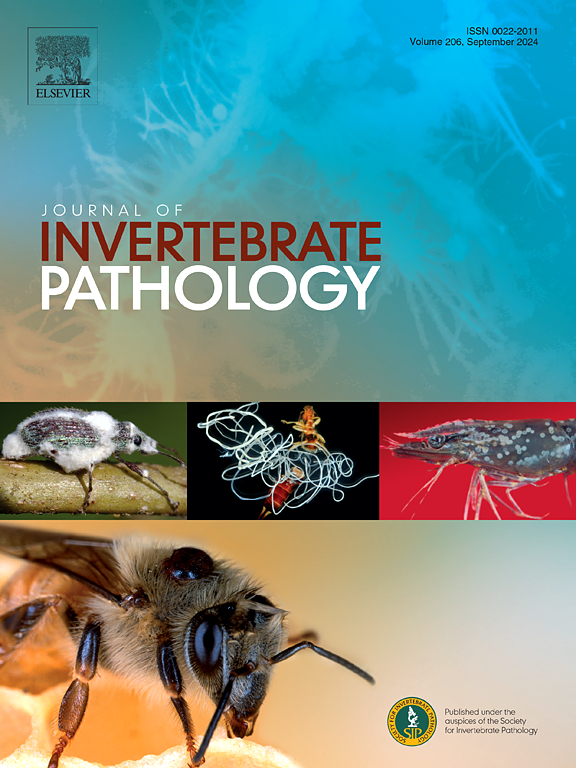Candidate DNA and RNA viruses of Drosophila suzukii from Canada and Germany, and their interactions with Wolbachia
IF 3.6
3区 生物学
Q1 ZOOLOGY
引用次数: 0
Abstract
Some species of insects harbour strains of the endosymbiotic bacteria Wolbachia that do not cause obvious reproductive manipulations, and so it is unclear why they persist in host populations. There is some evidence that some of these endosymbionts may provide their hosts with protection against viruses, which would help to explain their persistence, but few studies have explored associations between Wolbachia and naturally occurring, common viruses in natural populations. Here, we asked whether individuals of the invasive vinegar fly Drosophila suzukii infected with the wSuz strain of Wolbachia were less likely to be infected by naturally occurring viruses in its invaded range, in western North America and in Europe. First, using next-generation sequencing, we conducted a virome survey of adult and larval D. suzukii in British Columbia, Canada, finding eight candidate RNA viruses and two candidate DNA viruses; all but one have not been reported previously. Only the previously described Teise virus, an RNA virus, was abundant in our virome survey. We then screened individual flies from British Columbia and Germany for Teise virus and Wolbachia. Wolbachia-infected D. suzukii from the field were not less likely to be infected by Teise virus. Overall, our results do not provide conclusive evidence that wSuz provides strong protection for D. suzukii against viruses that are common in natural populations. However, the other viruses that we discovered in this study deserve further characterization in terms of their pathogenicity to D. suzukii and the frequency and dynamics of infection in wild populations.

来自加拿大和德国的苏氏果蝇候选DNA和RNA病毒及其与沃尔巴克氏体的相互作用。
有些种类的昆虫携带的内共生细菌沃尔巴克氏体菌株不会引起明显的繁殖操纵,因此尚不清楚为什么它们在宿主种群中持续存在。有一些证据表明,这些内共生菌中的一些可能为它们的宿主提供抗病毒的保护,这将有助于解释它们的持久性,但很少有研究探索沃尔巴克氏体与自然种群中自然存在的常见病毒之间的联系。在这里,我们询问感染wSuz沃尔巴克氏体菌株的入侵醋蝇铃木果蝇个体是否不太可能被其入侵范围内自然发生的病毒感染,在北美西部和欧洲。首先,我们利用新一代测序技术,对加拿大不列颠哥伦比亚省的猪嗜血杆菌成虫和幼虫进行了病毒组调查,发现8种候选RNA病毒和2种候选DNA病毒,除1种外,其他病毒均未报道过。在我们的病毒组调查中,只有先前描述的Teise病毒,一种RNA病毒是丰富的。然后,我们对来自不列颠哥伦比亚省和德国的个体苍蝇进行了泰兹病毒和沃尔巴克氏体的筛查。田间感染沃尔巴克氏体的猪嗜血杆菌感染泰泽病毒的可能性也不低。总的来说,我们的结果并没有提供确凿的证据,证明wSuz对自然人群中常见的病毒提供了强有力的保护。然而,我们在本研究中发现的其他病毒,特别是新的候选裸蝇病毒,在其对铃木氏疫病的致病性以及在野生种群中感染的频率和动态方面值得进一步表征。
本文章由计算机程序翻译,如有差异,请以英文原文为准。
求助全文
约1分钟内获得全文
求助全文
来源期刊
CiteScore
6.10
自引率
5.90%
发文量
94
审稿时长
1 months
期刊介绍:
The Journal of Invertebrate Pathology presents original research articles and notes on the induction and pathogenesis of diseases of invertebrates, including the suppression of diseases in beneficial species, and the use of diseases in controlling undesirable species. In addition, the journal publishes the results of physiological, morphological, genetic, immunological and ecological studies as related to the etiologic agents of diseases of invertebrates.
The Journal of Invertebrate Pathology is the adopted journal of the Society for Invertebrate Pathology, and is available to SIP members at a special reduced price.

 求助内容:
求助内容: 应助结果提醒方式:
应助结果提醒方式:


